If there is one thing that is consistent about the Japanese people that you should know about, is that they are meticulous about almost everything in their lives.
You can see it: every day plays out before your eyes like clockwork – from their daily routines, traffic & pedestrian management, trains always on time (or even earlier than their estimated time of arrival ETA), anime, food preparation, and a lot more!
Suffice it to say, it wouldn’t be fair to talk about the takohiki without mentioning the various types of Japanese kitchen knives, because there is a whole slew of them.
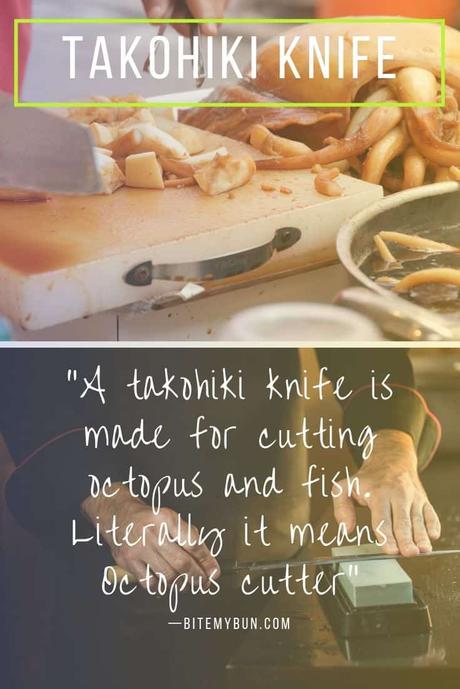
Japanese kitchen knives are bladed tools derived from ancient swords and are specially designed for food preparation.
These knives are often made using traditional Japanese blacksmithing techniques and each has a special purpose (i.e. you can’t use a knife that is used for cutting squid and octopus, like the Takohiki knife, or knives to cut or chop a different kind of meat).
For all your octopus and sashimi cutting, filleting, and cleaning needs the Yoshihiro Yasuki White Steel Takohiki Knife is a great pick because it has a traditional square tip and single bevel blade for extreme precision and sharpness.
Its length is great for raw fish when preparing Sushi or Sashimi and is especially perfect because of its square tip.
It’s definitely not the most expensive so I’ve got some more knives and reviews below of some of the most professional knives. But I personally decided to stay at under $150,- instead of spending close to $800,-.
First, let’s look at the best ones, then I’ll write detailed reviews down below so read on to see them all.
Takohiki knives
Images
Best overall takohiki knife: Yoshihiro Yasuki White Steel
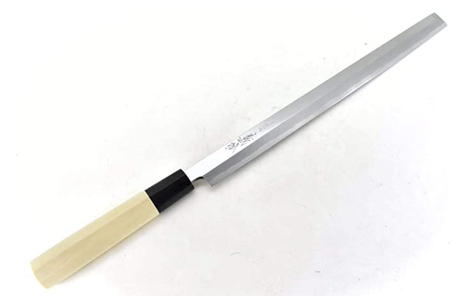
(view more images)
Best budget takohiki knife: KMZ Kitchen Japanese Sushi Sashimi
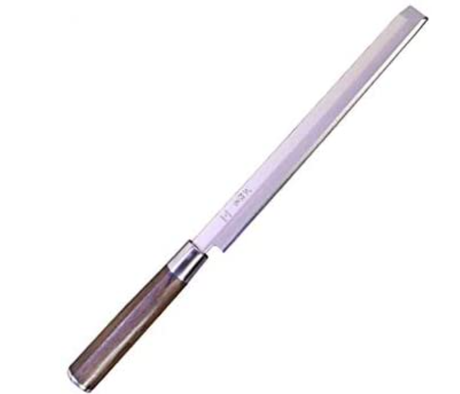
(view more images)
Best sakimaru takohiki knife: YOUSUNLONG Sakimaru Knife
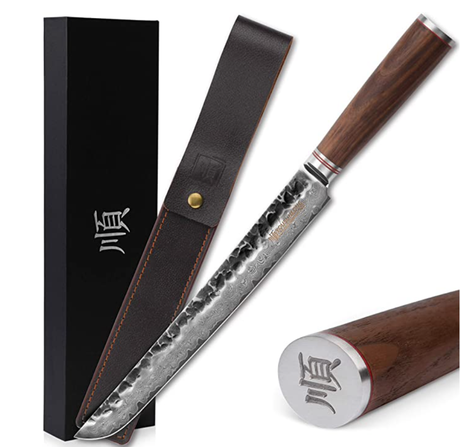
(view more images)
Best left-handed takohiki knife: Kasumitogi White Steel Takohiki
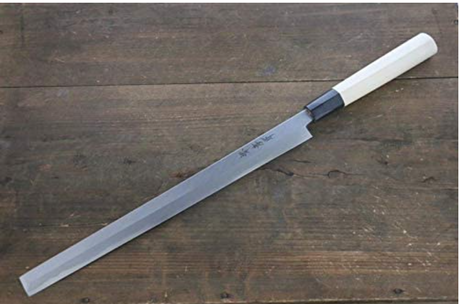
(view more images)
What is a takohiki knife?
The takohiki knife falls under the category of Yanagiba knives where the name takohiki literally translates to “octopus cutter”. It is a knife specifically designed to cut squid and octopus.
Yanagiba knives (Japanese for willow blade) are the most popular fish-cutting knives in Japan, and they also go by another name: shobu-bocho (sashimi knife).
Sushi chefs and specialists use the yanagiba knife to highlight different textures of fish in demonstrating their fish cutting techniques. The knife is used by pulling it towards you. It can really slice octopus, squid, and other raw fish for sashimi in one cut.
Yes, as incredible as it may sound, in Japan even cutting fish is considered an art, especially cutting fish for sushi.
The types of cuts are:
- Hirazukuri to pull cut vertically
- Usuzukuri to pull cut thin vertically
- Sogizukuri to pull cut at an angle
Yanagibas are used to scale, skin, and remove the bones of certain types of fish such as salmon, for example.
Kensaki or kiritsuke tip, yanagiba knives are usually heavier with angled tips and have less sloping.
The takohiki knife is a yanagiba variant (from a particular region in Japan) that is used exclusively to cut octopus (in making <takoyaki) and is lighter, thinner, flatter, and shorter in blade height than yanagiba.
This particular knife design allows for cutting through denser meat with ease like that of an octopus.
The average size of yanagiba knives as well as the takohiki is around 270 mm to 330 mm long.
Find out the secret on how to cook octopus [+ best Asian octopus dishes to try]
What is a sakimaru takohiki?
Like the takohiki, the sakimaru is just a variation of this knife. It is a combination of Yanagiba and takohiki which is used for cutting and slicing octopus, squid, and other raw fish and seafood too.
Thus, the sakimaru takohiki is used to prepare sashimi, not just octopus.
The blade has a straight spine and the edge is slightly curved so it’s a bit more curved than the traditional takohiki.
Most sakimaru knives have these three blade sizes: 270 mm, 300 mm, and 330 mm. The longer blades are better for cutting and slicing large fish and big octopi for sashimi.
Takohiki knife buying guide
A takohiki knife is an investment, so there are some must-have features you need to look out for before making a purchase.
Blade material
One of the main reasons why Japanese knives are so good is that they are made of a high-quality carbon steel blend (Hagane). Most bladesmiths also use Damascus steel which is great if you want very long-lasting knives.
This blade material is very durable, rust-proof and it is much lighter, thinner, and also holds its edge sharper for longer compared to other materials. As well, this type of knife blade won’t chip and shatter as quickly.
Stainless steel is also an option but it’s not as sharp and durable as the carbon still and it is prone to corrosion over time.
In many cases, Japanese knife is carefully handcrafted by artisans because reputable brands want to ensure the best quality.
Handle material
The premium Japanese knives have ho wood handles which makes them very lightweight to hold. This material is also durable and long-lasting, even though it’s wood. Thus, this porous wood handle makes for a very balanced knife and is crack-resistant.
You can also find laminated wood handles which are great too because you can use them with wet or greasy hands and they don’t slip or crack.
Leadwood is also a popular option, especially for cheaper and mid-range knives.
Finally, some handles are made of some plastic materials but these are good because they can be washed in the dishwasher.
I recommend getting a wood handle though if you want an authentic Japanese takohiki knife.
Blade length
Most takohiki knives have a blade length between 210 mm – 330 mm.
210 mm is best for slicing and dicing small or baby octopus, whereas 240 mm is a very common all-purpose size. The large 330 mm blade is usually reserved for restaurants that have to cut and clean large octopus and other seafood.
Bevel
Real and authentic takohiki knives have a single edge or single bevel blade.
Some Western-made or takohiki knockoffs will have a double bevel blade but those are harder to use because if you pull the knife back and forth while cutting the meat will have rough edges.
Sharpness
The takohiki knife has a thin single-bevel blade and as a result, the edge is ultra-sharp.
The sharper the knife, the better it will cut and you can make very precise and clean cuts in the octopus tentacles and the head. Sharpness also helps you remove the organs and pierce through the chewy texture.
Most of the takohiki knives are sharpened 10-15 degrees on one side of the knife blade. This 10-15 degree angle makes the knife extremely sharp.
Best takohiki knife brands
Following our discussion above we will now explore the different brands that manufacture and sells takohaki chef’s knife on the market.
Because sushi, sashimi, takoyaki and other seafood-based dishes have been exported throughout the world, the manufacturers featured in this list may not just include Japanese companies, but from other countries as well.
Below are some of the best takohiki knives that we highly recommend you buy if you’re making sushi and sashimi or are still in the process of deciding to make them soon.
Best overall takohiki knife: Yoshihiro Yasuki White Steel
- Blade length: 10.6” (270 mm)
- Blade material: white steel
- Handle: wood
- Bevel: single edge
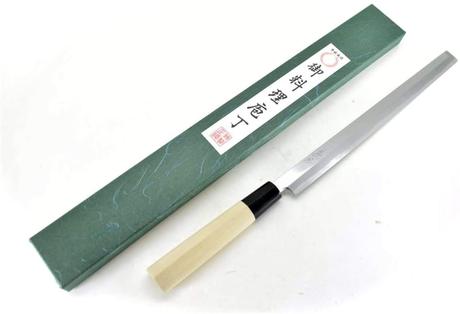
(view more images)
People love fresh sashimi and octopus dishes like Takoyaki. But, to make all of these dishes from scratch, you need the proper takohiki knife with a square tip to be able to carve, fillet and cut the food into small pieces.
If you’re looking for the top takohiki knife, it’s best to choose a well-trusted brand like Yoshihiro because it’s made by Japanese artisans using traditional forging and manufacturing methods.
This brand is best known for premium handcrafted cutlery and their Yasuki takohiki knife has the classic square tip. It is made in the Osaka region out of premium alloy called “white steel.”
If you’re right-handed, this knife is quite easy to use but you’ll have to get used to making cuts by pulling towards yourself to ensure clean cuts.
This single-bevel knife is extremely sharp, so beware because it’s very easy to cut yourself. But this guarantees the most precise cuts so you can cut and clean octopus.
The problem is that when you have to cut out the eyes, the blade must be super sharp and quite long, especially when you’re prepping a large octopus. Thus, the 10.6-inch blade is long enough to allow you to dig deep into the meat.
The knife has a real wooden handle with an octagonal shape and design. This ensures a firm grip and is comfortable to hold.
Although this is an expensive knife, it’s worth the money because it’s the kind of knife that can last for decades if properly maintained.
The only problem is that this knife is handwash only and you have to keep it dry always. As well, you need to take it to a specialist to get it professionally sharpened.
Overall, this knife is excellent for professional chefs or home cooks but it’s best suited for those preparing sashimi and octopus dishes like takoyaki, made from freshly diced octopus meat.
Check the latest prices here
Best budget takohiki knife: KMZ Kitchen Japanese Sushi Sashimi Takohiki Knife
- Blade length: 9.44” (240 mm)
- Blade material: high carbon steel
- Handle: wood
- Bevel: single edge
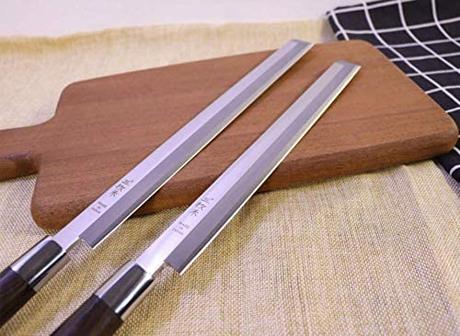
(view more images)
Want to start cooking fresh octopus at home and save money at the fishmongers? Then you can get a really good takohiki knife at a budget price from KMZ Kitchen.
Although this is not a famous Japanese brand, it’s a suitable alternative for those hundred-dollar knives.
The blade has a length of 9.4 inches, so it’s a bit smaller than the Yoshihiro, and it’s made of durable high-carbon German steel. Although German steel is different from Japanese steel, it’s usually what cheaper knives are made from because the cost is lower.
The knife is still good quality though and not as fragile.
Also, the blade is single-edged and is taper ground for extreme sharpness with a fine stone finish and a square tip.
According to the manufacturer, the blade is rust-proof, stain-proof, doesn’t corrode easily. However, if you wash the knife frequently you can experience some discoloration over time.
Again, this knife is designed for right-handed users. If you’re looking for a comfortable knife though, this one might not be the comfiest one because the handle is very straight and thin, much like the blade, so it slips from your hand. That’s why you need to use a firm grip.
The handle doesn’t have ridges or grooves so it’s not as secure in your hand. Make sure to practice holding it before you attempt to dissect your first octopus. Don’t pull it back and forth or you’ll end up with very roughly cut pieces.
The knife has quite a balanced feel to it and it’s lightweight so cutting those firm tentacles isn’t very hard.
Overall, this KMZ knife is a great choice for people who don’t want to invest too much money in a knife that they might not use too often. After all, you probably have a separate Yanagiba knife for sushi already, and this will be used for special octopus recipes.
Check the latest prices here
Yoshihiro vs KMZ
There’s a big difference between a Yoshihiro premium knife and a cheap one like the KMZ and it all comes down to build and overall quality. A forged takohiki is special because it’s made by skilled artisan bladesmiths in Japan.
These cheaper takohiki knives are mass-produced and the difference in design and build quality is visible. But, the takohiki is only used for octopus and sashimi so you probably don’t use it every day. So, if you’re just cooking at home making takoyaki and tako su (octopus salad), you probably don’t need the expensive Yoshihiro knife.
But, if you’re a chef, the sharpness and smoothness of the blade edge is noticeable so you want to invest in the best quality Yoshihiro knife that will last for many years.
Also, the Yoshihiro is made of a stronger and more durable steel alloy. In comparison, the KMZ is made with cheaper steel and is more prone to rust and stains.
If you’re curious, Yoshihiro knives are comparable to Shun knives but the takohiki from Yoshihiro is widely available and for a good price while Shun’s version is hard to find on the retail market.
It all comes down to your budget and preference. Both the Yoshihiro and KMZ have nice, sharp blades and square tips for similar performance.
Best sakimaru takohiki knife: YOUSUNLONG Sakimaru Knife
- Blade length: 11” (280 mm)
- Blade material: Damascus steel
- Handle: wood
- Bevel: double-edge
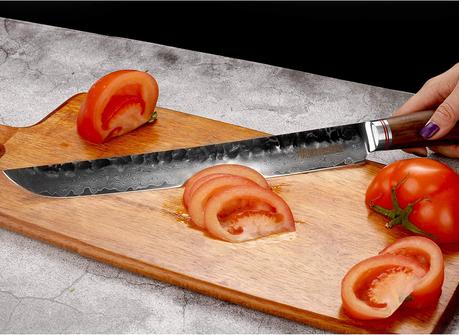
(view more images)
If you need a knife to make sashimi as well as cut octopus, then you need a combo knife like the Sakimaru Takohiki with a slightly curved edge. This Yousunlong knife is a mid-priced versatile knife suitable for preparing all kinds of seafood.
Sometimes, you need to cut squid or fresh salmon for sashimi but don’t have specialty sushi and fish knives on hand.
That’s when the Sakimaru comes in handy. It’s a variation on the takohiki with a similar straight spine but it has a slightly curved edge, making cutting smoother and easier.
This Western-inspired knife has a double edge which makes it much easier to use than a single bevel one.
The blades are sharpened to 15 degrees, so you can be sure you can make precise cuts on the first try. Therefore, you can cut all the raw squid, octopus, and fish into small sashimi-sized pieces.
The knife looks impressive and much more expensive than it really is because of its beautiful walnut handle. It is die-casted and covered with an outer layer of walnut. Thus, it’s really comfortable to maneuver and doesn’t make your hands tired.
It’s a durable knife and should last you quite a few years. But one thing that you might find a bit annoying is the hammered finish.
This hammered finish is also supposed to be non-stick and more suitable for Western users who aren’t used to using thin and smooth blade Japanese knives.
While the small grooves ensure the food doesn’t stick to the edges of the blade, the final cut is not quite as smooth as a traditional takohiki knife. If you plan on carving fish though, you’ll enjoy using this knife because the thin strips of fish won’t stick so you can carry out the work faster.
My final opinion is that since the blade has a hardness of 60, it will still make really quick and precise cuts and the knife itself is incredibly strong. It doesn’t crack or chip easily and maintains its sharpness pretty well.
Therefore, it’s a great purchase at a reasonable price and it’s more versatile than other takohiki knives.
Check the latest prices here
Also check out these gorgeous hammered copper cookware sets (+why choose hammered?)
Best left-handed takohiki knife: Kasumitogi White Steel
- Blade length: 8.2” (210 mm)
- Blade material: white steel
- Handle: wood
- Bevel: single edge
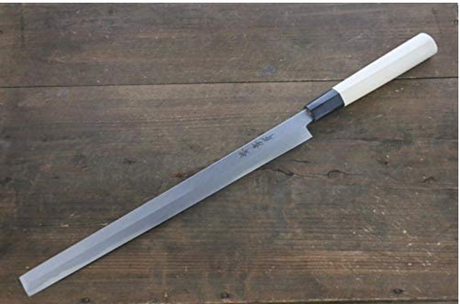
(view more images)
Being left-handed is a real struggle when it comes to finding specialty Japanese knives. Luckily, manufacturers are making left-handed knives too so chefs and home cooks can find a high-quality takohiki knife no matter what.
The only setback is the huge price – but this is an authentic Japanese knife that will last a lifetime. So, invest once and enjoy it forever.
Since it’s a forged knife, it doesn’t come apart like many of the budget knives you can find. That’s the difference between a cheap knife and a premium Japanese hand-crafted tool.
The Kasumitogi is a premium takohiki knife designed for professional chefs and restaurant use. This brand has been making artisan Japanese knives in Sakai for over 600 years, so you can really count on good quality.
It is made of white alloy steel, which is extremely durable and lasts a lifetime when cared for properly. Also, it is a single bevel blade so it’s best for slicing, filleting, and dicing octopus and other seafood.
Compared to the other knives on this list, this one is a bit smaller but just as precise and sharp. The tip is completely square so you can remove organs in a few moves.
The handle is solid ironwood with an octagonal design which is easy to hold and offers a comfy, firm grip. Using this leftie knife is just as easy as using the righty version and you can work just as fast.
Never attempt to cut through bones and frozen octopus though or the knife can chip and crack. It’s designed for use on fresh, raw meat exclusively.
This knife can replace some of your other fish and sushi knives, because I know it’s hard to find these types of knives as a leftie.
If you would also like to have other Japanese knife types in your arsenal, I’ve listed the top 8 chef’s choice options for lefties here.
If you’re wondering what the difference between Kasumitogi and the top-rated Yoshihiro knife is, it comes down to price and how well it holds its edges.
The Kasumitogi holds its sharpness for longer but the Yoshihiro is much more affordable.
Check the latest prices here
Japanese kitchen knives
Exclusivity is the forte of Japanese kitchen knives which is very different from Western culture.
Since the age of the samurais ended with the ushering of the Meiji Restoration (明治 Meiji), Japanese blacksmiths shifted their work from sword making to kitchen knife crafting and created successful businesses out of it.
Before the industrial revolution in the late 19th-century Japanese swordsmiths used tamahagane (玉鋼:たまはがね), or “jewel steel” to make kitchen knives.
This is also the same steel used to make the katana which is the sword that the legendary samurais used for battle.
When the modern age arrived modern swordsmiths now use as much stainless steel as the tamahagane in creating high-quality kitchen knives.
The Japanese would often refer to their kitchen knives as hocho (包丁/庖丁) or bocho (due to rendaku – a sequential voicing in Japanese morphophonology).
Sometimes kitchen knives are also called kiri (〜切りor “cutter”) as well as other names depending on how they are used or what they are used for.
Japanese kitchen knives have 4 general categories, including:
- Its handle (Western vs. Japanese)
- Its blade grind (single bevel vs. double bevel)
- The kind of steel used to manufacture it (stainless vs. carbon), and
- Its construction (laminated vs. mono steel)
Also read: these Kiritsuke knives are traditionally only for the head chef
Design and use
Japanese knives are mostly crafted with only a single ground; this means that the swordsmith only sharpens one side of the blade to form its cutting edge, which is very different from the Western grind on kitchen knives.
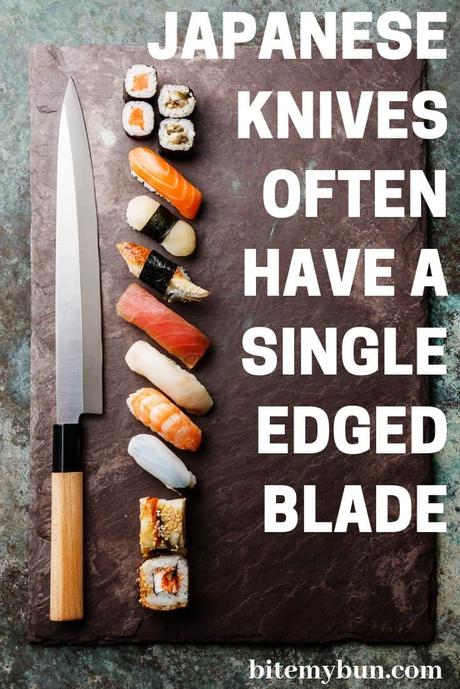
However, there are also Japanese kitchen knives that have a double bevel and both sides of the blade are sharpened.
Both swordsmiths and chefs traditionally believed that single-beveled blades made better and cleaner cuts than knives with a double-beveled edge, except the former required the user to be more skilled in using the blade.
Swordsmiths often make the right-hand side of the knife’s blade angled because most people are right-handed.
This makes the knife easy to use and helps the chef/cook prepare food more efficiently.
Left-handed models are rare and must be specially ordered and custom-made.
Conclusion
If you’re a chef or just a Japanese food enthusiast who is on your way to cooking great Japanese cuisines, then you should consider the tools you’ll need to do this.
The takohiki is a great kitchen knife and it can help you make great sushis and sashimis, not to mention takoyaki as well.
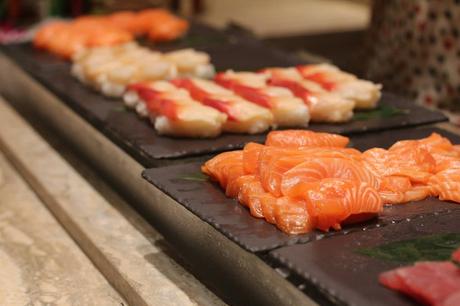
Of course, there are dozens of other specially made Japanese kitchen knives that you will need when you’ll cook other recipes.
I still think the Yoshihiro is the most advantageous pick because of its outstanding quality and mid-range price.
But you may want to start with the takohiki and making sushi first before venturing into other dishes.
Also read: best Yattoko cooking pot for traditional Japanese cooking
